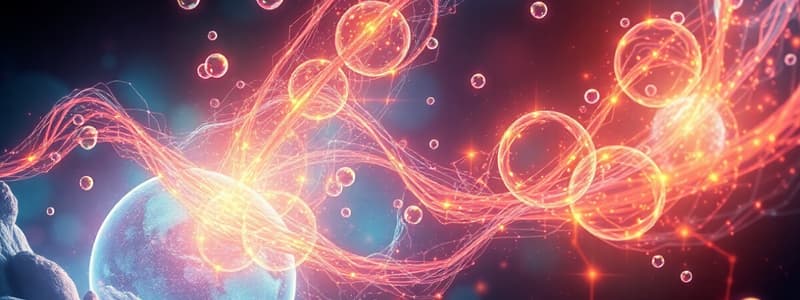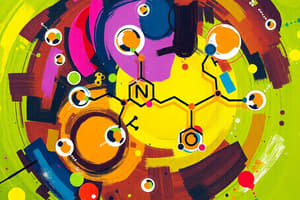Podcast
Questions and Answers
Explain how increasing the temperature affects the distribution of molecular energies in a gas, according to the Maxwell-Boltzmann distribution, and how this relates to reaction rate.
Explain how increasing the temperature affects the distribution of molecular energies in a gas, according to the Maxwell-Boltzmann distribution, and how this relates to reaction rate.
Increasing temperature broadens the Maxwell-Boltzmann distribution, shifting it to higher energies. This means more molecules possess the activation energy, leading to a higher reaction rate.
How does the presence of a catalyst affect the activation energy of a reaction, and what is the consequence of this change on the reaction rate?
How does the presence of a catalyst affect the activation energy of a reaction, and what is the consequence of this change on the reaction rate?
A catalyst lowers the activation energy by providing an alternate reaction pathway. This allows a greater proportion of molecules to react, increasing the reaction rate.
For the reaction A + B → C, the experimental rate equation is Rate = k[A]^2[B]. What can be inferred about the reaction mechanism from this rate equation?
For the reaction A + B → C, the experimental rate equation is Rate = k[A]^2[B]. What can be inferred about the reaction mechanism from this rate equation?
The rate-determining step involves two molecules of A and one molecule of B. Any steps occurring after this one do not affect the overall rate.
What is the significance of the pre-exponential factor (A) in the Arrhenius equation, and how does it relate to the success of molecular collisions?
What is the significance of the pre-exponential factor (A) in the Arrhenius equation, and how does it relate to the success of molecular collisions?
Describe how you would use the method of initial rates to determine the rate equation for a reaction involving two reactants, A and B.
Describe how you would use the method of initial rates to determine the rate equation for a reaction involving two reactants, A and B.
Explain why increasing the surface area of a solid reactant generally increases the reaction rate.
Explain why increasing the surface area of a solid reactant generally increases the reaction rate.
For a first-order reaction, how is the half-life related to the rate constant, and what does this imply about the time it takes for the reaction to reach completion?
For a first-order reaction, how is the half-life related to the rate constant, and what does this imply about the time it takes for the reaction to reach completion?
How can plotting ln(k) vs. 1/T be used to determine the activation energy of a reaction?
How can plotting ln(k) vs. 1/T be used to determine the activation energy of a reaction?
Distinguish between a homogenous and a heterogenous catalyst, giving an example of each.
Distinguish between a homogenous and a heterogenous catalyst, giving an example of each.
Explain what a rate-determining step is in a reaction mechanism, and why it is important in understanding the overall rate of a reaction.
Explain what a rate-determining step is in a reaction mechanism, and why it is important in understanding the overall rate of a reaction.
Flashcards
Rate of Reaction
Rate of Reaction
Change in concentration of reactants or products per unit time, measured in mol dm⁻³ s⁻¹.
Catalysis
Catalysis
Catalysts increase reaction rates by providing an alternative pathway with a lower activation energy; they are not consumed in the reaction.
Activation Energy (Ea)
Activation Energy (Ea)
The minimum energy required for a reaction to occur; catalysts lower this energy requirement.
Rate Equation
Rate Equation
Expresses the relationship between the rate of a reaction and the concentrations of reactants: Rate = k[A]^m[B]^n.
Signup and view all the flashcards
Rate Constant (k)
Rate Constant (k)
A constant specific to a reaction at a particular temperature, reflecting reaction speed; units depend on overall reaction order.
Signup and view all the flashcards
Half-Life (t1/2)
Half-Life (t1/2)
Time taken for the concentration of a reactant to decrease to half its initial value; constant for a first-order reaction.
Signup and view all the flashcards
Rate-Determining Step
Rate-Determining Step
The slowest step in a multi-step reaction mechanism that determines the overall reaction rate.
Signup and view all the flashcards
Arrhenius Equation
Arrhenius Equation
Describes the relationship between rate constant (k), temperature (T), and activation energy (Ea): k = Ae^(-Ea/RT).
Signup and view all the flashcards
Reaction Mechanism
Reaction Mechanism
A step-by-step description of how a reaction occurs, including the sequence of elementary steps.
Signup and view all the flashcardsStudy Notes
All the provided text is already in the existing study notes, therefore no changes are required.
Studying That Suits You
Use AI to generate personalized quizzes and flashcards to suit your learning preferences.



